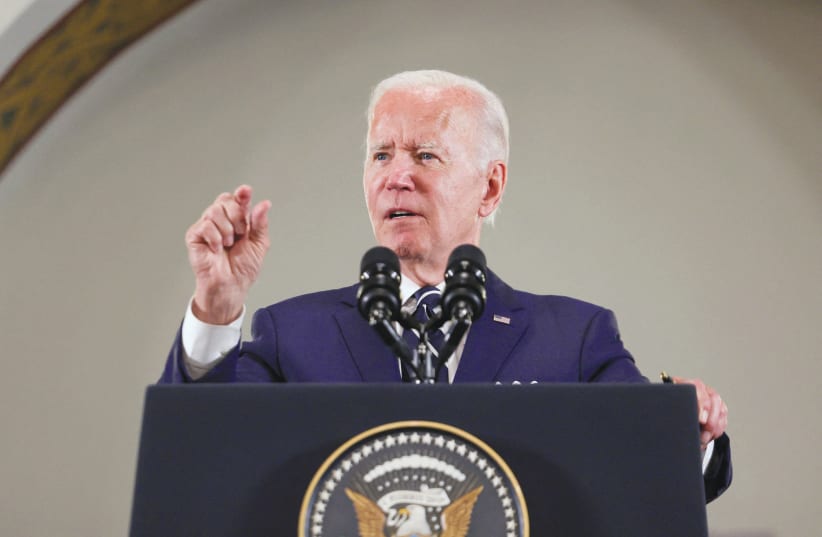For three days last month, the skies again filled with drones, F-16s and 1,100 rockets, terrorizing millions and killing and wounding dozens. This last round of acute Israeli-Palestinian violence should remind everyone that the conflict is not over or managed. This is what the decades-long, constantly-deteriorating status quo looks like. Bloodshed rises and falls, but it’s always there, grinding on.
Predictably, once the shooting starts, so does the self-righteous media war. Partisans pointlessly do battle over who was the bigger aggressor or victim, who was right and wrong. What a waste. Imagine if instead we directed all that energy to the serious, painstaking work of taking apart the structural factors that cause this to keep happening.
Easier said than done. Both Israelis and Palestinians feel stuck. Too many have accepted this as an unavoidable reality. Everyone knows that violence is an option, however futile. But few see any alternative.
Both sides have spent the last two decades wondering: How can we make peace without a trustworthy partner?
As Huda Abuarquob and I wrote in January, that’s why hundreds of grassroots initiatives – and a recent US law, MEPPA – look beyond the stalemate du jour to focus on the long term. Today, there is no political-diplomatic leadership or vocal public constituency for peace. So, a growing ecosystem of peace-building NGOs is strengthening the relationships and attitudes that the next generation of Israelis and Palestinians will need if they’re ever to exit this tragedy. MEPPA commits $250 million over five years to scale up such economic and civil society partnerships.
It’s been just one year since USAID’s flagship Partnership for Peace Fund opened its doors. Already, the US chose five major project investments at $2m. to $5m. each (with more sure to come). Combined, they will touch thousands of Israelis and Palestinians across diverse sectors. With these first grants, women entrepreneurs, major businesses, environmental researchers, youth activists, health care providers, and IT students will jointly access new financing, mentors, markets, trading partners, environmental advocacy training, healthcare partners and IT skills.


But MEPPA is not just an annual budget line for each year’s most interesting projects. Its multi-year horizon, ambition for policy change and call for international leverage set it apart. NGOs, US decision makers, other nations and private philanthropists are all investing in parallel in the peace-building ecosystem. How can we all maximize the next few years together?
In a new paper published this week by Mitvim – The Israeli Institute for Regional Foreign Policies – I look back over what’s been accomplished in the last year and what exciting opportunities have opened up as MEPPA’s second year begins. The paper’s detailed considerations for stakeholders focus on three major questions.
How can we be most strategic?
First, how can we be most strategic? Where do we want to be in a decade’s time? If today’s peace-building programs engage tens of thousands of people, what will it take to reach millions? What would a balanced investment portfolio look like across different demographics and locales? How do we ensure that every project – including economic ones – leads to conflict transformation? How do we build one initiative upon another in a growing progression? What metrics will we use to know when it’s working?
THIS MOMENT of big investment begs for a field-wide master plan, identifying concrete goals over the next five, 10 and 20 years. A group of conflict resolution and regional experts could add critical input. A new impact app and standardized metrics could help funders and practitioners alike measure progress and identify areas of need and opportunity.
Who can be our partners and who's missing?
Second, who can be our partners, and who’s missing from the table? Both smaller NGOs and underserved communities come to mind. There are many small – and medium-size peace-building NGOs, which matured over the last two decades but are not yet ready for multi-million-dollar projects.
They could really level up with smaller grants (perhaps $300,000 to $1.5m.), plus capacity-building support. Likewise, more projects can learn from recent success in engaging “unusual suspects” in peace building, including religious and more conservative communities. Though delicate and often quiet, this work fills an important gap.
How do we leverage this into even more?
With a conflict so powerful and resourced, the third major question is how do we leverage this major five-year investment into even more? One way is for more projects to seek systemic change. When public schools adopt an NGO’s curriculum, for example, the impact spreads exponentially as tens of thousands of students benefit.
Peace building can also gain leverage by working more with program graduates, helping them navigate their home communities, connect with each other and act for change. With funder support, more programs can implement these high-leverage practices on the ground.
Yet, one year in, MEPPA’s greatest potential for leverage and impact still sits on the international stage. This bold, unprecedented US investment could be a cornerstone in building a $200 million-per-year International Fund for Israeli-Palestinian Peace. Indeed, the success of the International Fund for Ireland, which began tilling the soil for peace twelve years before the Good Friday Accord, underscores the power of this model.
Creating an institution with the mandate, resources, credibility, and expertise to change the dynamics of this conflict is a bigger project than any one nation or donor can achieve alone. As international support grows and before time runs out, now is the moment to secure MEPPA’s longest-lasting legacy: launching a long-term push to help the next generation find their partners and their way out of this mess once and for all.
The writer is the founder and president of the Alliance for Middle East Peace (ALLMEP), the coalition of over 150 Israeli-Palestinian people-to-people peace-building organizations whose campaign to create an International Fund for Israeli-Palestinian Peace led to the passage of MEPPA. He also serves as a Mitvim visiting fellow.
